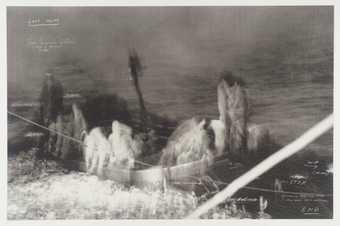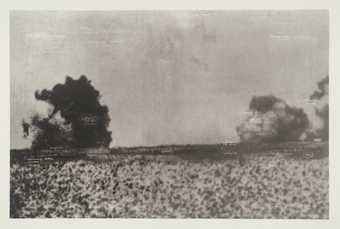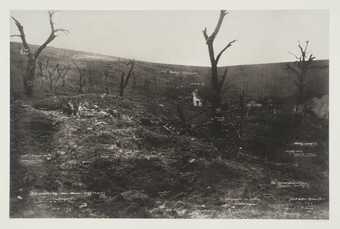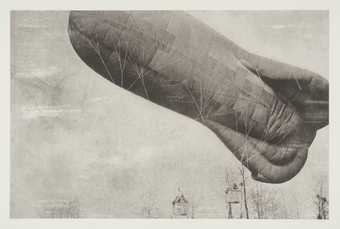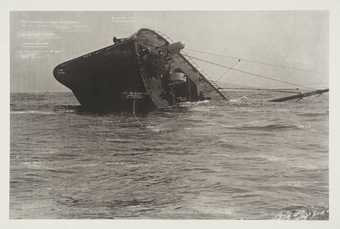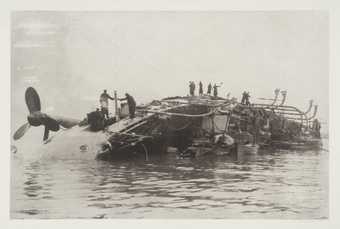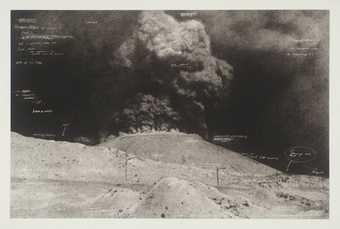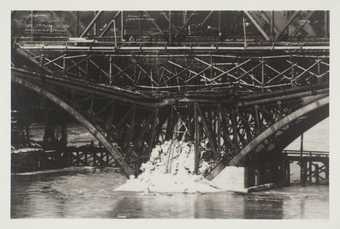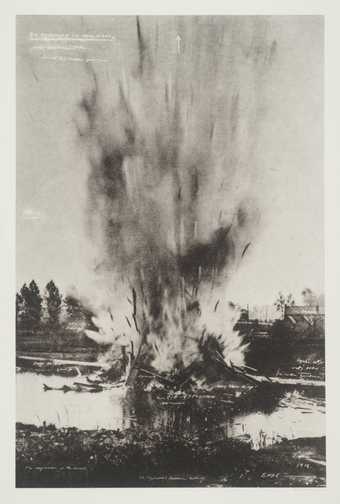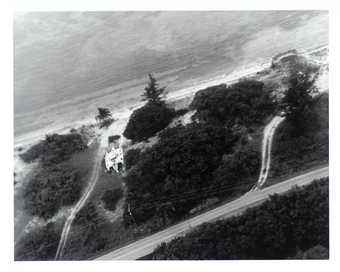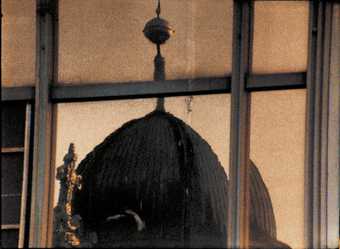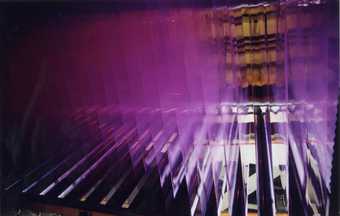On loan
Auckland Art Gallery (Auckland, New Zealand): Light
- Artist
- Tacita Dean CBE born 1965
- Medium
- Film, 16 mm, projection, colour and sound
- Dimensions
- Collection
- Tate
- Acquisition
- Purchased 1998
- Reference
- T07455
Summary
Created by the British artist Tacita Dean, Disappearance at Sea 1996 is a 16 mm colour film with sound shot on location at the lighthouse on St Abb’s Head in Berwick-upon-Tweed in northern England. Shown on a loop, the fourteen-minute film consists of seven lengthy shots captured by a static camera that alternate between close-ups of the rotating lighthouse bulbs and footage looking out to sea. As the film progresses the scene changes from dusk to nightfall, with the colour of the sky shifting through a range of yellows, reds and purples. The soundtrack features the noise of seagulls, waves and the wind, as well as the rhythmic mechanical movements of the lighthouse machinery. The film ends with a shot of lighthouse beams panning the darkened coastline as the seagulls’ cries reach a crescendo. It is displayed in a dedicated darkened room with benched seating, grey walls and a light-lock entrance. In this room, the film is projected onto a thin white wooden screen hanging on the gallery wall at a frame size of approximately 2800 mm by 1050 mm. Sound is provided through two speakers located in the corners of the same wall on which the screen hangs. The version of Disappearance at Sea owned by Tate is the third in an edition of three.
Disappearance at Sea was shot by the cinematographer John Adderley, who has worked with Dean on several of her films, and was made using a specially adapted anamorphic lens that lends the image an extended depth and breadth. Following the filming, the footage was edited by Dean in London. The work was made for the Berwick Ramparts Project, in which contemporary artists were invited to respond in different ways to the character of Berwick-upon-Tweed, and was first screened at the St Abb’s Head lighthouse in 1996. In 1998 the film was shown at the Tate Gallery, London, as part of an exhibition displaying works by nominees for that year’s Turner Prize.
The film was inspired by the story of Donald Crowhurst (1932–1969), a British businessman and amateur sailor who died while attempting a voyage around the world during which he falsified his progress. In 1997 Dean explained how she has interpreted Crowhurst’s expedition:
His story is about human failing; about pitching his sanity against the sea; where there is no human presence or support system left on which to hang a tortured psychological state. His was a world of acute solitude, filled with the ramblings of a troubled mind.
(Quoted in Frith Street Gallery 1997, p.17.)
The ‘disappearance’ referred to in the work’s title can be seen as an allusion both to Crowhurst’s death and to the sunset and eventual darkness the film depicts. Furthermore, the feelings of temporal disorientation Dean creates – the passage of time covered in the film does not correspond with real time – may be linked to Crowhurst’s own confusion at sea. In 2001 the curator Clarrie Wallis suggested that Dean’s fascination with the sea ‘can be traced back to eighteenth-century notions of the sublime, where elemental forces were viewed as emblems of turbulent and ungovernable human emotions’ (quoted in Tate Britain 2001, p.9).
Disappearance at Sea can be connected to a number of related works completed by Dean in 1995–7, including Disappearance at Sea I–VI 1995, a series of six chalkboards featuring maritime sketches and labels; three postcard works featuring the St Abb’s Head lighthouse and the town in Devon from which Crowhurst set sail on his voyage around the world; the artist’s book Disappearance at Sea 1997; and the four-minute 16 mm colour film Disappearance at Sea II 1997, shot at the Longstone lighthouse in Northumberland, a location famed for the rescue feats performed there in 1838 by Grace Darling, the daughter of the lighthouse keeper.
Dean trained as a painter but began making films in 1992, producing works characterised by long takes and an exploration of narrative, memory and history. After moving to Berlin in 2000 Dean made several works about German architecture and culture, including the film Fernsehturm 2001 (Tate T07871). Her continued interest in the relationship between filmic technology and notions of obsolescence can be seen in works such as Kodak 2006 (Tate T12407), which was shot at the Kodak factory in eastern France using the last 16 mm film stock produced there, and FILM 2011 (Tate T14273), a 35 mm projection that was installed in the Turbine Hall at Tate Modern, London, in 2011.
Further reading
Tacita Dean: Missing Narratives, exhibition catalogue, Frith Street Gallery, London 1997, pp.14–18, reproduced pp.19–21.
The Turner Prize 1998, exhibition catalogue, Tate Gallery, London 1998, pp.6–7, reproduced p.6.
Tacita Dean: Recent Films and Other Works, exhibition catalogue, Tate Britain, London 2001, pp.9–11, 18–19, 26, 74–5, reproduced p.11.
Richard Martin
July 2015
Supported by Christie’s.
Does this text contain inaccurate information or language that you feel we should improve or change? We would like to hear from you.
Explore
- architecture(30,960)
-
- public and municipal(2,385)
-
- lighthouse(333)
- formal qualities(12,454)
-
- photographic(4,673)
You might like
-
Tacita Dean CBE Ship of Death
2001 -
Tacita Dean CBE The Crimea
2001 -
Tacita Dean CBE The Wrecking of the Ngahere
2001 -
Tacita Dean CBE Erinnerung aus dem Weltkrieg
2001 -
Tacita Dean CBE Ballon des Aérostiers de Campagne
2001 -
Tacita Dean CBE The Sinking of the SS Plympton
2001 -
Tacita Dean CBE Götterdämmerung
2001 -
Tacita Dean CBE The Wreck of Worthing Pier
2001 -
Tacita Dean CBE So They Sank Her!
2001 -
Tacita Dean CBE Vesuvio
2001 -
Tacita Dean CBE The Tragedy of Hughesovka Bridge
2001 -
Tacita Dean CBE Die Explosion in dem Kanal
2001 -
Tacita Dean CBE Aerial View of Teignmouth Electron, Cayman Brac 16th of September 1998
2000 -
Tacita Dean CBE Palast
2004 -
Tacita Dean CBE Kodak
2006


